From 1st February to 30th April 2019, you will save around £70 on the cost of a scale and polish under general anaesthetic. During this offer period cat scale and polish procedures are £105 and dogs are £125. You will also be given information on preventative dental health care and free post operative nurse appointments to check the condition of your cat or dogs freshly cleaned teeth.
Dash the lurcher was one of the first dogs to benefit from this offer. Vet Rob had examined his mouth during a routine consultation and identified tartar, gum recession and enamel erosion. A few of his teeth were also worn. Rob recommended that Dash had a dental scale and polish to remove tartar and prevent immediate plaque build-up. Here is a behind the scenes look at how Dash spent his day, and should answer any questions you may have.
N.B: this offer does not include extractions, dental radiography, pre anaesthetic bloods, fluid therapy or additional medications.
What causes dental problems?
When food remnants accumulate within the mouth, a clear and sticky film called plaque forms. Plaque combines with saliva to form tartar, or calculus. Tartar is a brown and hard substance that grows around the tooth. It cannot be removed with brushing and will result in other dental problems, such as gingivitis and periodontal disease, if left untreated. Dental problems can be species, breed or age specific.
How will I know if my pet has a dental issue?
You may notice that your pets’ breath smells unpleasant (halitosis), or see changes in the appearance of the teeth or gums. If your pet is very young, it is common for them to lose deciduous teeth (baby teeth) because the adult teeth are growing through. Sometimes these teeth do not fall out at the appropriate time and can become misaligned, resulting in discomfort. Dash had already had a deciduous tooth removed during another procedure.
If you are unsure about your pets’ teeth, please see your vet or nurse. They will assess the condition of their mouth and general health. If appropriate, a vet may recommend a dental procedure under general anaesthetic, and/or advise you on preventative care.
Why is it important for me to look after my pet's teeth?
Unlike us, cats and dogs cannot independently clean their teeth so they need a bit of help from owners to prevent tooth loss, infections and dental diseases.
Gingivitis causes the gums to become red and swollen. They may bleed, start to recess or become sensitive to touch. Periodontal disease is an inflammation within the tooth structure. It is caused by excessive tartar along the tooth and gum line, and results in loss of bone and tissue. Periodontal disease is one of the most common diseases in dogs, especially in older pets.
“It is estimated that 70-80% of cats and dogs over 2 years old have some signs of periodontal disease” (Kruuse, 2019)
Dogs are prone to dental cavities; these can harbour pus and bacteria which may enter the blood stream and affect other major organs, including the heart, liver and kidneys. Dogs who chew will often have worn or fractured teeth. Fractures can extend to the nerve and cause pain and abscesses. Cats are prone to resorptive lesions or tooth erosion, also known as feline resorptive lesions (FLR). These are holes, or lesions, within the enamel of the tooth and are not always obvious as these lesions are often below the gum line, but they are painful. Dental pain will ultimately make it difficult for your pet to eat, and may result in weight loss, reduced grooming and changes in temperament.
“It has been estimated that more than 70% of cats over five years have at least one FRL.” (ICatCare.org 2019.)
What does a dental involve?
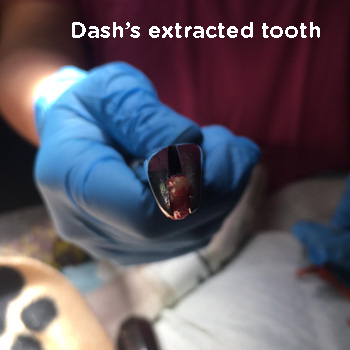
A vet will advise you on the dental procedure necessary, and will provide you with an estimate of costs. Dash required a scale and polish using an ultrasonic cleaner, with extractions.
Extractions are not always obvious; some are only identifiable after careful probing of the teeth and gum line, whilst others become apparent after dental radiography (x-rays). X-rays assess the parts of the teeth that we cannot see. Loss of density or bone around a tooth can indicate periodontal disease and the need for extraction(s).
If your pet is older or there are other health concerns, the Vet may recommend pre anaesthetic bloods. These assess the function of the liver and kidneys and identify abnormalities that need treatment or consideration for the anaesthetic. The liver and kidneys excrete the anaesthetic and may be affected by commonly used drugs during the dental procedure. Dash was a young and otherwise healthy dog, so bloods were not taken. Dash did, however, have intravenous fluid therapy. Fluids help to support the heart, blood pressure, temperature and pet’s hydration status. Often, this helps to shorten recovery time and is advisable in older patients.
What happens on the day of the dental?
Dash was admitted for his procedure by Hollie, one of our Registered Veterinary Nurses (RVN). Dash’s family were given time to ask questions and check that all of their contact details were up to date. Once Dash had said ‘see you later!’ to his family, he was checked over by Katie to ensure he was in good health for surgery.
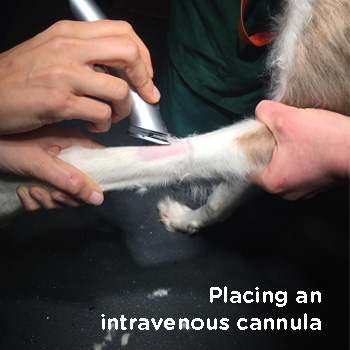
An intravenous cannula was placed into Dash’s foreleg for the administration of intravenous fluids and a pre-medication to help him relax, and lower the dose of anaesthetic required. Whilst the premedication took effect, Dash was closely monitored in a warm and comfortable kennel by our vet, Katie, nurses Hollie and Kimberley.
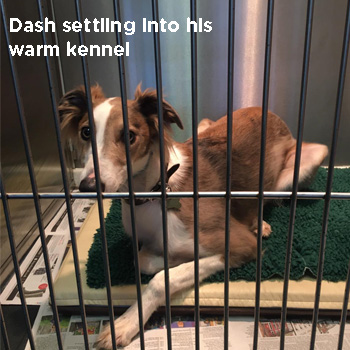
When Dash was looking sleepy, Katie and Hollie moved him into the prep area for his pre anaesthetic checks. An intravenous anaesthetic agent was injected into the cannula to induce anaesthesia, before Dash was intubated and connected to oxygen. Anaesthetic gas was then introduced to maintain the anaesthetic at the correct depth. Throughout the procedure, Dash’s reflexes, heart rate, breathing rate, colour, blood pressure and oxygen levels were closely observed by Hollie to ensure he was in a suitable level of anaesthesia.
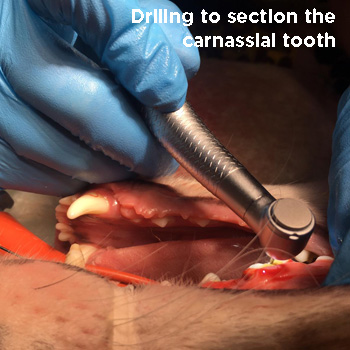
Before Katie started to scale, extract or polish teeth, a dental chart was completed. This chart records the current condition of the teeth, including those that may be missing. Dash had two teeth removed during his dental and a few abnormalities observed and recorded on the dental chart. This helps to identify the correct preventative care needed, and is a good baseline for future dental work.
Sometimes teeth will be easily extracted once the tartar is removed, whilst others need encouragement. A selection of tools are used to help elevate the tooth and the root out of the socket. A dental drill may also be required to section the tooth into smaller sections. The scaling and polishing is done after other work is completed, and results in a fresh smile!Before Katie started to scale, extract or polish teeth, a dental chart was completed. This chart records the current condition of the teeth, including those that may be missing. Dash had two teeth removed during his dental and a few abnormalities observed and recorded on the dental chart. This helps to identify the correct preventative care needed, and is a good baseline for future dental work.
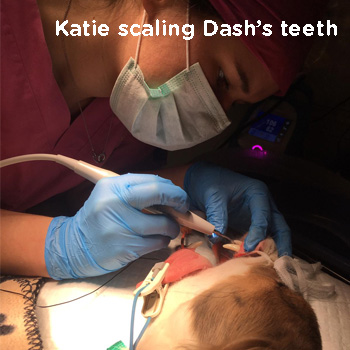
Dental procedures can take time so it is important patients are kept warm. A bair hugger was used on Dash – this is a blanket that fills with warm air. It is used alongside foil blankets and an intravenous fluid warmer to maintain body temperature, which is checked regularly. During an anaesthetic, patients are not left unattended. Dash’s heart rate, respiratory rate, colour, blood pressure, fluid rate and reflexes were recorded every five minutes and necessary changes made.
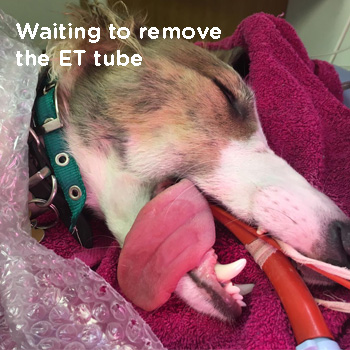
When the dental procedure was finished, the recovery process starts. Dash was given plenty of oxygen via his endotracheal tube until his normal reflexes started to return. As soon as Dash was ready to swallow, the endotracheal tube and the mouth pack could be carefully removed. A mouth pack is used in dental procedures to absorb any excess water within the mouth and prevent any from being inhaled during the anaesthetic.

Dash’s face was dried before he was moved to the warmth of the kennel ward. Our dedicated recovery nurse, Hayley, then began her post operative checks. Patients are not left alone until they can independently lift their head and appear alert. Throughout the day, their vital signs are checked and any concerns are addressed straight away. This includes signs of pain and concerns about the wound. Dash’s mouth was looking good after surgery – he had stitches in place so these were monitored and any concerns recorded.
Dash had lots of cuddles during recovery and received quite a bit of TLC… our nurse Hollie handfed Dash his lunch! A walk in the garden also gave him chance to go the toilet and smell new things!
What happens after the dental?
Dash and his family came back to see us for a post operative check a few days after his dental. His teeth were still looking great and his mouth had healed well from the extractions. Preventative dental care was then discussed with his family to help maintain Dash’s lovely new teeth. A free dental pack was given with ideas and advice. It also included a free Royal Canin Dental Diet sample!
Our nurses are happy to talk with you in detail about the right preventative care for your pet, and demonstrate if needed.

Thank you to Dash and his family for allowing us to use him for this dental blog. I think he had a nice day with us!